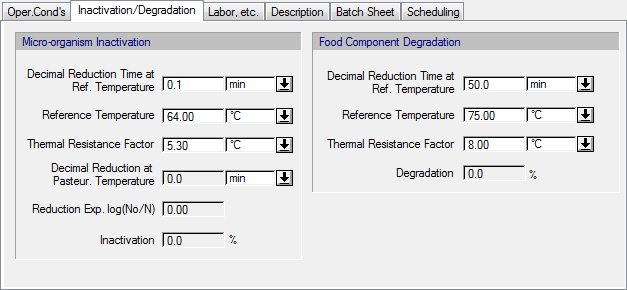

The following table shows a brief description of the variables appearing in this tab. The table also displays their default values and their generally acceptable range:
|
Variable |
Default Value |
Range |
|
|
||
|
○ Decimal Reduction Time at Ref. Temperature. (min) |
0.1 |
Positive |
|
○ Reference Temperature (oC) |
64 |
Positive |
|
○ Thermal Resistance Factor (oC) |
0.0 |
Positive |
|
● Decimal Reduction Time at Pasteur. Temperature(min) The decimal reduction time of the microorganism of interest at the pasteurization tempearure. |
0.0 |
Positive
|
|
● Reduction Exponent log(N0/N)
|
0.0 |
Positive |
|
● Inactivation The % inactivation of the microorganism during the pasteurization process. |
0.0% |
0 - 99% |
|
○ Decimal Reduction Time at Ref. Temperature. (min) |
50.0 |
Positive |
|
○ Reference Temperature (oC) |
75.0 |
Positive
|
|
○ Thermal Resistance Factor (oC) |
8.0 |
Positive |
|
● Degradation The % percentage degradation of the nutritious food component during the pasteurization process.
|
0.0 |
Positive |
Symbol Key: ○ User-specified value (always input); ● Calculated value (always output); ◙ Sometimes input, sometimes output
By providing appropriate values for the microorganism inactivation and food component degradation kinetics, the user is able to estimate the impact of the pasteurization process to the quality of food. In that sense, different pasteurization policies can be simulated (i.e., w.r.t to the pasteurization temperature and residence time in the holding tube) in order to perform a trial-and-error optimization of the pasteurization process.